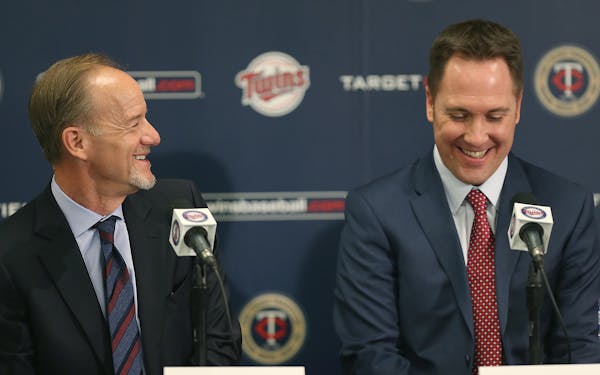The Twins on Saturday inducted Johan Santana into their Hall of Fame. During his speech, he thanked former general managers Terry Ryan and Bill Smith, the alpha and omega of his Twins career, who made him their poster pitcher for team building and rebuilding.
Santana's induction arrived 18 years after they traded for him in the Rule 5 draft, a clearinghouse for disappointing minor leaguers.
And 17 years after he posted a 6.49 ERA in his first big-league season, 14 years after he won his first Cy Young, and 10 years after trading him for a spotty slew of prospects.
Santana embodies the traditional and ongoing Twins philosophy: Trade for undeveloped prospects, slowly develop them, then trade the developed player to restart the cycle.
Twins fans seemed shocked when Derek Falvey and Thad Levine traded big-leaguers for prospects in each of their first two seasons. To be shocked is to ignore history, and the state of the current farm system.
Andy MacPhail won two World Series as Twins GM. If his philosophy were a shoe slogan, it would be: Just Do It … Or Don't Even Bother Trying.
Ryan built a team that produced six playoff appearances in nine seasons, with Smith running the team for the last two of those. Ryan, like MacPhail, believed in pouring gasoline on the franchise when champagne wasn't earned.
Falvey and Levine traded for help last summer, then traded away players when the team slumped before the deadline. They traded for help this spring, then traded away a fifth of the big-league roster this summer.
They are unintentionally paying homage to MacPhail and Ryan, who believed that if you can't win this year, you start working on your three-year plan.
At the time Ryan traded for him, Santana wasn't even a decent prospect. Ryan had already traded Chuck Knoblauch for Cristian Guzman and Eric Milton. While the Twins were losing enough to tempt baseball to eliminate the franchise, Ryan was slowly building.
He had learned under MacPhail, who won a World Series in 1987, then traded his Cy Young-winning, changeup-throwing lefty, Frank Viola, for two young pitchers in 1989. The Twins would not have won in 1991 without Kevin Tapani and Rick Aguilera.
When Ryan stepped down, Smith immediately faced a nasty task — trading the great Santana, who was a year away from free agency and whose representatives had given the Twins no hope of being able to re-sign him. Smith dealt Santana to the Mets for outfielder Carlos Gomez and pitchers Phil Humber, Kevin Mulvey and Deolis Guerra. Gomez would emerge as a star… after the Twins traded him. The pitchers would not help.
Smith had confirmed the risks of trading for unestablished players. There are risks associated with inaction, as well. Had Falvey and Levine decided not to trade players away, most likely this year's team would have missed the playoffs anyway, and the Twins would be without 11 prospects they received in their five July deals.
Want to blame someone for this year's failure? Instead of picking on a front office that added players with strong track records this winter, how about blaming Miguel Sano, Brian Dozier, Jorge Polanco and Max Kepler for failures and absences? Or blame injuries to Ervin Santana, Byron Buxton, Jason Castro, Addison Reed. Or all of the above.
Falvey and Levine were hired because the franchise required a reboot and the farm system lacked depth. Trading for prospects gives the Twins a puncher's chance at building a sustainable winner.
For those who think Falvey and Levine should be selling out to try to win immediately, consider this:
If Twins ownership thought the team was ready to win in the latter years of this decade, Ryan would still be here.
So Falvey and Levine continue to do what is logical and, in the Twins' organization, traditional: trading players who are about to leave before they leave, trying to find the next Santana while understanding that they're bound to get stuck with a few Humbers.

Souhan: This is KAT's chance to prove Flip Saunders was right

Souhan: Why Tiger Woods should keep swinging
Souhan: Scheffler wins Masters again, shows what makes him special
Morikawa falters in final round at Masters


